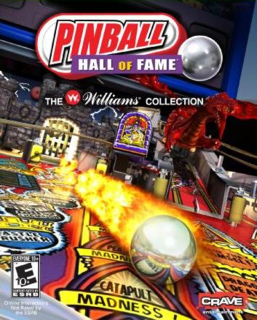The PHOF series keeps getting better ... how about another edition, please?
For this edition, Crave turned to the classic tables of Williams, one of history's most highly-regarded pinball manufacturers. The 10 tables represented here offer a broad contrast in style and complexity, but all feature a highly-competent physics engine, clear sound and colorful, sharp graphics. The level of detail and fidelity to the original tables is exceptional, handily beating the "UltraPin" virtual pinball machine found in some bars/arcades.
The base control scheme, using the Wii Remote and Nunchuk, is well-suited for this use. Flippers are operated using the triggers on the two controllers (Z & B), while the control stick on the Nunchuk stands in for the plunger. Admittedly it's odd launching with the left hand instead of the right, but it doesn't take too long to adapt. Shaking the Nunchuk will nudge the table; just as on a real machine, a little jostling of the table is acceptable, but too much will Tilt the machine and end your turn. I found myself shaking the Nunchuk during normal gameplay, when things got a little too hectic, but it was never enough to tilt the machine.
It'll be easy to find a table or two to like in this game:
Jive Time (1970): the oldest game in the collection, with the simplest layout and sound effects.
Gorgar (1979): a classic table with a Hyborean Age graphic style, including some familiar sound effects.
Firepower (1980): space-age themed machine that debuted a number of now-common pinball features.
Black Knight (1980): legendary enough to spawn a sequel almost a decade later. Tilting the control stick left or right operates the game's revolutionary "MagnaSave" feature on that side.
Sorcerer (1980): targets galore, multi-ball play and a taunting voice track.
Space Shuttle (1984): a fitting tribute to the then-new shuttle program with lots of opportunities for bonuses and save features.
Pinbot (1986): probably the most famous table for video-gamers, thanks to Rare's superb rendition for the NES.
Taxi (1988): a catchy theme song and funny voice track liven up this fun-to-play table.
Whirlwind (1990): fast-paced, very colorful and high-scoring. Challenging, but not frustrating.
Funhouse (1990): Another high-scoring table that will taunt the player into "just one more game" all too often.
Some of the games are already unlocked in "free play" mode, while others require you to use "credits" earned in-game. Just as in the real games, you earn extra credits by beating certain scores; here, these earned credits go into your "account" and can be used on other games.
The non-free games can be "purchased" with credits, or unlocked by completing "goals." Each table has two sets of five goals each, which can be completed in any mode. Completing the first five regular goals unlocks the table for free play (if you haven't already done so with credits) and opens the Wizard goals. Completing those goals unlocks a number of gameplay options, including turning off the tilt system and allowing the player to change the ball, giving it a globe pattern, a smiley-face, or other graphics.
Up to four players can play, each with their own remote/nunchuk combo or using just one set for everyone. Tournament-mode lets up to four players compete for top overall score using from one to all 10 tables. The Williams Challenge has you playing each table in turn, attempting to reach a minimum score in order to advance.
Overall, the gameplay and setup are exceptional, but not flawless. Once all tables are unlocked, credits become useless; no bonus art, no hidden tables, no nothing. The goals give you something to shoot for, but occasionally, when the Wizard goals open, you'll see things you've already done, but they don't count unless you do them now. To be fair, these are minor quibbles and don't really detract from the quality of this budget-priced title.
So, what can they do for an encore? There are some awesome 80s-00s pinball tables that deserve some attention, such as Black Knight 2000 and Earthshaker (complete with rumble feature, of course). The keyword in all this is "encore," something this game sorely needs.

